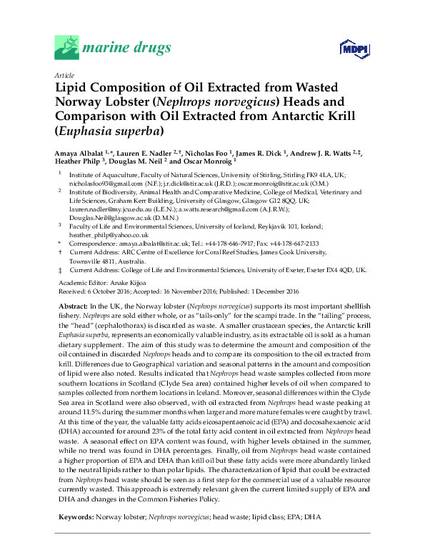
- Norway lobster,
- Nephrops norvegicus,
- Head waste,
- Lipid class,
- EPA,
- DHA
In the UK, the Norway lobster (Nephrops norvegicus) supports its most important shellfish fishery. Nephrops are sold either whole, or as “tails-only” for the scampi trade. In the “tailing” process, the “head” (cephalothorax) is discarded as waste. A smaller crustacean species, the Antarctic krill Euphasia superba, represents an economically valuable industry, as its extractable oil is sold as a human dietary supplement. The aim of this study was to determine the amount and composition of the oil contained in discarded Nephrops heads and to compare its composition to the oil extracted from krill. Differences due to Geographical variation and seasonal patterns in the amount and composition of lipid were also noted. Results indicated that Nephrops head waste samples collected from more southern locations in Scotland (Clyde Sea area) contained higher levels of oil when compared to samples collected from northern locations in Iceland. Moreover, seasonal differences within the Clyde Sea area in Scotland were also observed, with oil extracted from Nephrops head waste peaking at around 11.5% during the summer months when larger and more mature females were caught by trawl. At this time of the year, the valuable fatty acids eicosapentaenoic acid (EPA) and docosahexaenoic acid (DHA) accounted for around 23% of the total fatty acid content in oil extracted from Nephrops head waste. A seasonal effect on EPA content was found, with higher levels obtained in the summer, while no trend was found in DHA percentages. Finally, oil from Nephrops head waste contained a higher proportion of EPA and DHA than krill oil but these fatty acids were more abundantly linked to the neutral lipids rather to than polar lipids. The characterization of lipid that could be extracted from Nephrops head waste should be seen as a first step for the commercial use of a valuable resource currently wasted. This approach is extremely relevant given the current limited supply of EPA and DHA and changes in the Common Fisheries Policy.
Available at: http://works.bepress.com/lauren-nadler/23/

©2016 by the authors; licensee MDPI, Basel, Switzerland. This article is an open access article distributed under the terms and conditions of the Creative Commons Attribution (CC-BY) license (http://creativecommons.org/licenses/by/4.0/).